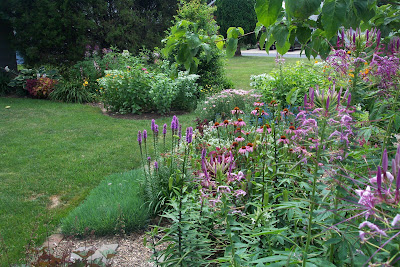 .
.The last several days I’ve been deadheading daffodils, hyacinths and tulips.

As the flowers fade I snip the stalk. I don’t want seeds to develop. You can see the seed head beginning to form on the daffodil as a bulge behind the flower. Ripe seeds could grow into a new daffodil. But, it takes 5 to 7 years to bloom – if you do everything right. Much better to buy bulbs or divide existing clumps.

As the flowers fade I snip the stalk. I don’t want seeds to develop. You can see the seed head beginning to form on the daffodil as a bulge behind the flower. Ripe seeds could grow into a new daffodil. But, it takes 5 to 7 years to bloom – if you do everything right. Much better to buy bulbs or divide existing clumps.
.

Making seed saps the bulb's energy. I want the energy to go into the bulb so it can produce blooms next year. The leaves remain to nourish the bulbs. One year I folded and rubber banded all the leaves. Not only was it time consuming but I think it looked worse than yellowing leaves. I’m also not sure how much nourishment the bulbs got from those little knots. I don’t think anyone recommends that method today.
I planted perennials near some bulbs to camouflage the fading leaves. Lilies, asters, cone flowers, black-eyed susans, hosta and daylilies do a good job hiding the fading bulb foliage. Sometimes I plant annuals in front of the clump. I add a little bone m eal or Bulb Tone.
eal or Bulb Tone.
I snip the cuttings into two to four inch pieces and compost them. They make colorful compost, don’t they?
.
(More information on growing bulbs from Ohio State University Extension, Purdue University Extension “Flowering Bulbs” .)

Making seed saps the bulb's energy. I want the energy to go into the bulb so it can produce blooms next year. The leaves remain to nourish the bulbs. One year I folded and rubber banded all the leaves. Not only was it time consuming but I think it looked worse than yellowing leaves. I’m also not sure how much nourishment the bulbs got from those little knots. I don’t think anyone recommends that method today.
I planted perennials near some bulbs to camouflage the fading leaves. Lilies, asters, cone flowers, black-eyed susans, hosta and daylilies do a good job hiding the fading bulb foliage. Sometimes I plant annuals in front of the clump. I add a little bone m
 eal or Bulb Tone.
eal or Bulb Tone.I snip the cuttings into two to four inch pieces and compost them. They make colorful compost, don’t they?
.
(More information on growing bulbs from Ohio State University Extension, Purdue University Extension “Flowering Bulbs” .)
.





 .
.


 .
.



 .
.







